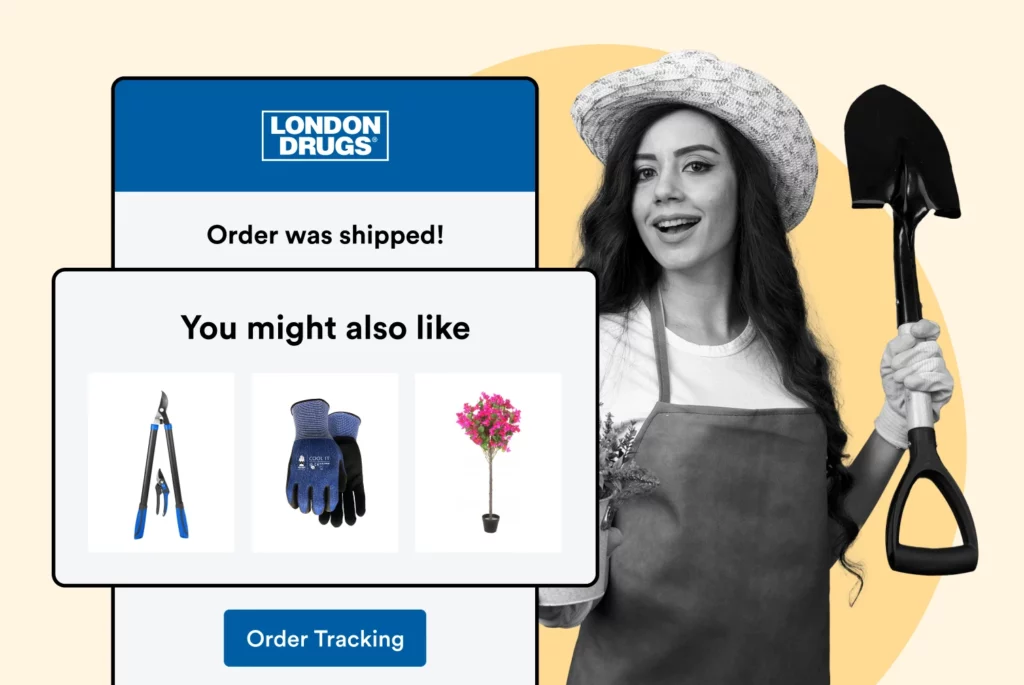
Maximizing Customer Loyalty with an Omni-Channel Returns Policy
Discover how maximizing customer loyalty through an effective omnichannel returns policy can be a game-changer in the e-commerce industry.
Boost customer experience and reduce support tickets
Realtime order and shipment tracking
Proactive order and shipping notifications
Predictive pre-purchase estimated delivery dates
Self-Serivce branded order tracking
Effortless experience delivered
Make returns profitable and delight customers
Flexibility to define any return destinations & conditions
Simplify returns for your customers and team
Incentivize exchanges over returns
Returns management made easy for your team
Understand why your customers are returning
Unify the online and the in-store experience
Hassle-free pickup experience for customers
In-Store Dashboard to keep operations streamlined
In-Store and Online orders unified
Drive foot-traffic to your stores
Boost customer experience and reduce support tickets
Realtime order and shipment tracking
Proactive order and shipping notifications
Predictive pre-purchase estimated delivery dates
Self-Serivce branded order tracking
Effortless experience delivered
Make returns profitable and delight customers
Flexibility to define any return destinations & conditions
Simplify returns for your customers and team
Incentivize exchanges over returns
Returns management made easy for your team
Understand why your customers are returning
Unify the online and the in-store experience
Hassle-free pickup experience for customers
In-Store Dashboard to keep operations streamlined
In-Store and Online orders unified
Drive foot-traffic to your stores
Find the answer to all your questions
Explore the most comon questions about WeSupply
Calculate the ROI that WeSupply can bring you
Request a no strings attached review of your current shopping experience and missed conversion opportunities
Take a step by step trip through our functionality to see how we can improve your ecommerce processes.
Read actionable articles on how to optimize your post-purchase experience and decrease support tickets
Get inspired by stories of how our customers implemented an effortless post-purchase experience
A Deep Dive into Top Companies' Order Tracking & Returns Strategy
Wondering if WeSupply is a good fit for you? Read through our use cases to see how we can help you increase conversion & improve CX!

Ecommerce returns play a pivotal role in shaping the ecommerce returns impact on customer experience and driving business success. With return rates averaging between 20-30% for online purchases, understanding and managing returns effectively is crucial for ecommerce businesses. In this blog post, we will explore the factors influencing customer satisfaction in ecommerce returns, strategies for streamlining the return process, and the future trends that could reshape the ecommerce returns impact on customer experience in the world of online shopping.
Returns are essential to ecommerce, impacting customer satisfaction and creating second-chance sales.
Businesses must prioritize providing outstanding customer experiences through innovative solutions such as automation, AI, and data analytics.
Return management is a key strategy to drive customer loyalty and long-term relationships for businesses in the competitive ecommerce market.
WeSupply streamlines eCommerce returns with user-friendly automation and customizable policies. It enhances customer experience through proactive notifications, personalized offers, and data analytics. By incentivizing exchanges and providing a branded returns portal, WeSupply turns returns into opportunities for increasing customer loyalty and brand growth.
The return process is an integral part of the online shopping experience, and its impact on customer satisfaction and loyalty is immense. A seamless return process can enhance customer trust and satisfaction, leading to increased customer loyalty and long-term relationships.
On the other hand, a poor return experience can drive customers away, resulting in lost sales and damage to the brand’s reputation.
Product returns hold weight in ecommerce due to their influence on customer satisfaction and quality assurance, also creating potential for second-chance sales. Given that online return rates fluctuate between 16.5% and 30%, analyzing return data to grasp its financial consequences becomes a necessity for ecommerce businesses.
Optimizing the return process and addressing common issues can improve customer satisfaction, minimize losses, and maximize revenue.
The ecommerce market is flourishing, with projections showing the global market might amount to $6.3 trillion by 2023. Amid such fierce competition, offering an optimized customer experience becomes a basic prerequisite for businesses to differentiate themselves and prosper. The level of competition in ecommerce directly impacts customer experience, prompting companies to deliver personalized experiences, prioritize customer satisfaction, and optimize delivery and return processes.
In the competitive ecommerce market, customer experience serves as a crucial distinguishing factor. An inferior customer experience might lead 89% of customers to migrate to a rival brand. By offering a distinctive and tailored experience, businesses can attract and convert customers more effectively, providing them with a competitive edge in the market. From optimizing website functionality to delivering exceptional customer service, every aspect of the customer journey must be considered to ensure success in the ecommerce landscape.
Further, the advent of digital technologies coupled with evolving customer expectations has encouraged businesses to adopt innovative solutions to simplify return processes. Tools like automation, AI, and data analytics are leveraged to amplify customer satisfaction and minimize return-associated costs. As a result, businesses that prioritize and invest in providing exceptional customer experiences are more likely to thrive in the competitive ecommerce market.
Ecommerce returns manifest in numerous forms, including returns for refund, cancellation of orders, and “Return to Sender” policies. Understanding these different return scenarios and their implications is essential for businesses to manage ecommerce returns effectively and ensure customer satisfaction.
Each type of return in ecommerce has its own impact on the customer experience. The different types of returns include:
Refunds: This involves returning the item and receiving a refund.
Replacements: This involves exchanging the item for a different one.
Cancelled order returns: This occurs when a customer decides to modify their order after it has been placed.
Final sale returns, on the other hand, are policies where customers are not allowed to return or exchange purchased items, typically applied to items that cannot be resold or are priced very low. By understanding these different return scenarios, businesses can develop strategies to optimize their return processes and enhance customer satisfaction.
WeSupply revolutionizes the returns process by prioritizing exchanges over simple refunds. Their approach not only salvages sales but also increases average order value through instant store credit incentives. Customers are rewarded for choosing store credit over direct refunds, and are seamlessly directed back to the product catalog to encourage further purchases. WeSupply facilitates various exchange options, allowing items to be swapped for different products, reshipped items, or items of equal or higher value. Additionally, refunds are transformed into future shopping opportunities by automatically issuing store credits, gift cards, or coupon codes. This strategy not only retains customer engagement but also fosters a trusting and loyal relationship between the brand and its customers.
Customers might return products due to a range of reasons including:
unfulfilled expectations
damaged or defective products
incorrect fit
change of mind
Knowing these common reasons for product returns in ecommerce can help businesses address potential issues and enhance customer satisfaction.
Fit issues, quality concerns, and change of mind are some of the most common reasons for returns in ecommerce. For instance, customers may return items due to inaccurate product descriptions or sizing information, which leads to unmet expectations and dissatisfaction.
By understanding these typical reasons for returns, businesses can take proactive steps to improve their product offerings, accurate product descriptions, and sizing information, ultimately reducing return rates and enhancing customer satisfaction.
WeSupply offers insightful analytics for eCommerce businesses to understand the dynamics of product returns. By identifying the most returned products and the reasons behind these returns, including fit issues, quality concerns, or a change of mind, businesses can optimize their offerings. WeSupply also highlights patterns in customer behavior, such as identifying serial returners. This data allows for improvements in products and processes, enhancing profit margins. Collecting customer feedback on exchanged products and understanding the financial impact of returns are key features. WeSupply also provides region-specific return data, offering a comprehensive view of customer satisfaction and product performance.
Return policies significantly sway consumer behavior and conversion rates in ecommerce. Costs related to restocking, shipping, and brief return windows might deter shoppers from purchasing from a brand.
On the other hand, offering flexible return policies and free return shipping can significantly impact customer loyalty and conversion rates.
Transparent, fair, and customer-friendly return policies play a crucial role in influencing shopping decisions and customer loyalty. By providing a clear and straightforward return process, customers are more likely to trust the brand and make repeat purchases. In fact, studies show that 91% of consumers believe that the ease of returns affects their decision to shop with a retailer again.
Thus, businesses must prioritize offering transparent, fair, and customer-friendly return policies to build customer loyalty and ensure long-term success.
WeSupply revolutionizes eCommerce with transparent, customer-friendly return policies, significantly impacting shopping decisions. Its advanced system allows for smart, cost-effective return processing and automation of diverse return policies. Businesses can customize policies, managing aspects like final sale items and return windows, streamlining operations and enhancing customer trust. This approach saves time and aids in revenue recovery, making WeSupply a key tool for improving the online shopping experience.
Several elements influence customer satisfaction during ecommerce returns, including:
The clarity of the policy
The complexity of the process
Processing time
The quality of customer service
These factors play a significant role in determining whether a customer has a positive or negative return experience, which can ultimately impact their loyalty, relationship with the brand, and customer lifetime value.
Policy clarity is essential for ensuring customer satisfaction in ecommerce returns. A clear and transparent return policy instills customer confidence and ensures they understand the conditions for returns, such as time limits and acceptable return reasons. On the other hand, a complex or unclear return policy can cause confusion and frustration, leading to customer dissatisfaction and potentially lost sales.
Process complexity and processing time also play a significant role in customer satisfaction during returns. An efficient and straightforward return process can improve customer satisfaction by providing a seamless experience and resolving issues promptly. Conversely, a lengthy and complex return process can generate frustration and negatively affect customer satisfaction. Moreover, timely processing of refunds is essential to avoid poor customer experience and customer attrition. By focusing on these key elements, businesses can optimize their return processes to enhance customer satisfaction and loyalty.
Simplifying the return process is a necessity for improving customer satisfaction in ecommerce. By simplifying the return process, businesses can provide a more user-friendly experience for customers, resulting in increased satisfaction and loyalty.
Some best practices for simplifying the return process to improve customer satisfaction include:
Facilitating easy returns requests
Maintaining a clear and transparent return policy
Offering multiple return options
Enabling customers to initiate returns via the website or mobile app.
By implementing these strategies, businesses can streamline their return processes, improve customer satisfaction, and foster customer loyalty.
WeSupply streamlines the return process, enhancing customer satisfaction through several key features:
Multiple Return Options: Encourages exchanges over returns, offering incentives like instant store credit and promoting exchanges and credit coupons.
Branded Returns Portal: Creates a branded, omnichannel experience with customizable tracking pages, email, and SMS notifications, fostering customer loyalty.
This approach not only simplifies returns but also enhances the overall post-purchase experience, building trust and encouraging repeat business. Ready to transform your returns process? Book a demo with WeSupply now and see the difference!
Create custom return policies
There are many moving pieces in ecommerce logistics. Book a quick call with our experts to see how WeSupply can help you take control by creating custom policies to handle them all easily. You get to decide how you want to handle final sale items, return window lengths, return request approvals, and more.
Businesses can adopt a variety of strategies to refine the ecommerce return experience and bolster customer loyalty. By focusing on enhancing communication, offering return incentives, and implementing fair policies, businesses can create a positive return experience that fosters long-term customer relationships.
Enhancing communication is a crucial aspect of improving the return experience. By providing clear instructions on how to return items, updating customers on the status of their return, and ensuring a transparent return policy, businesses can build trust and improve customer satisfaction. A customer service representative plays a vital role in this process by effectively communicating with customers.
Offering return incentives, such as store credit or discounts for equal or greater value replacement items, encourages customers to opt for an exchange rather than a refund, increasing the likelihood of repeat customers and boosting customer satisfaction.
Lastly, implementing fair policies, such as offering free return shipping and ensuring a timely refund process, can significantly enhance the overall return experience and contribute to customer loyalty.
WeSupply enhances the eCommerce return experience with strategic features:
These strategies not only streamline the return process but also turn returns into opportunities for customer retention and satisfaction.
Utilizing return data is critical for stimulating ongoing enhancement and comprehending customer preferences in ecommerce. By analyzing return patterns and preferences, businesses can make data-driven decisions to optimize their return processes, enhance customer satisfaction, and ultimately, drive growth.
Analyzing return data enables businesses to identify patterns and preferences of customers, which can be used to enhance product offerings and improve customer satisfaction. By understanding the reasons behind returns, businesses can address potential issues and make improvements to their product descriptions, sizing information, and overall customer experience.
Additionally, analyzing return data can assist in segmenting customers based on their preferences and buying patterns, enabling targeted marketing strategies that cater to their specific needs.
WeSupply leverages data to continuously improve the eCommerce return experience. Their Returns Analytics tool enables businesses to understand customer return behaviors by identifying the most returned products, the reasons behind these returns, and patterns among serial returners. This insight helps in reducing return rates through actionable insights. Benefits include SKU-level analysis to pinpoint return reasons like color, quality, and size, and collecting product feedback directly from customers. WeSupply also aids in understanding the financial impact of returns and exchanges, with data segmented by region and return reason. Emphasizing a data-driven approach, WeSupply provides tools to track CSAT and NPS, enabling businesses to fine-tune their processes and offerings based on real customer feedback and preferences.
The psychology underlying returns significantly molds customer loyalty and enduring relationships with brands. A positive return experience can foster trust and customer satisfaction, leading to increased loyalty and repeat purchases.
On the other hand, negative return experiences can drive customers away and damage the reputation of the brand.
Customer perceptions of returns have a considerable influence on their loyalty and relationship with the brand. When customers have a pleasant experience with returns, they are more likely to trust the brand and make repeat purchases. Conversely, a troublesome returns experience can drive customers away and damage the reputation of the brand.
Therefore, businesses must prioritize offering a smooth and efficient return process to sustain customer loyalty, avert negative word-of-mouth, and gather valuable customer feedback.
Several ecommerce brands have excelled in return management and customer satisfaction by implementing effective return policies and processes. By learning from these successful case studies, businesses can optimize their return strategies and enhance customer loyalty.
Evereve, a women’s fashion retailer, faced challenges with their return process, including:
Lack of responsibility for returns management
Lack of collaboration between essential teams
Overwhelmed customer service representatives with support queries related to returns
To address these issues, Evereve leveraged WeSupply, an ecommerce returns management solution, to revolutionize its returns process and transition from a manual, disjointed system to an automated, unified platform.
As a result of WeSupply’s interventions, Evereve improved the post-purchase experience through seamless communication, efficient order tracking, and automating the returns process. This led to heightened customer satisfaction, enhanced efficiency, reduced expenses, and increased customer loyalty. By turning returns into opportunities, Evereve demonstrates the power of effective return management and the importance of prioritizing customer satisfaction in ecommerce. Unlock success secrets: Read Evereve’s full case study and see how WeSupply elevated their returns game!
Combat inconvenience with proactivity & self service
Book a quick call with our experts to see how WeSupply can help you make returns easy for your customers with a beautiful, self-service solution that makes their experience easier while also providing new ways to lower costs and earn back revenue.
The future trajectory of ecommerce returns is likely to be influenced by emerging trends and innovations like automation, AI, and data analytics. As ecommerce continues to grow, businesses must adapt and evolve their return processes to enhance customer satisfaction and remain competitive in the market.
Future trends in ecommerce returns include increased automation, AI-driven analytics, and innovative return solutions like instant refunds and reusable packaging. These trends could reshape the customer experience by providing more streamlined, efficient, and convenient return processes, ultimately encouraging future purchases.
As technology continues to revolutionize the ecommerce landscape, businesses must stay ahead of these trends and adapt their return strategies to meet changing customer expectations and deliver a seamless, enjoyable online shopping experience for online purchases.
In closing, efficient management of ecommerce returns is imperative for businesses to guarantee customer satisfaction and foster enduring relationships. By integrating returns into a holistic customer relationship strategy, businesses can enhance customer loyalty, improve overall customer experience, and drive growth.
Businesses must perpetually assess and enhance their return processes and policies to maintain competitiveness in the dynamically changing ecommerce environment.
The role of returns in enhancing customer loyalty and long-term relationships cannot be overstated. Providing a smooth and efficient return process can:
Boost customer satisfaction
Foster trust and confidence
Stimulate repeat purchases
Create positive word-of-mouth
Ultimately lead to heightened brand loyalty.
By prioritizing return management as part of their overall customer experience strategy, businesses can ensure their continued success in the competitive ecommerce market.
In summary, ecommerce returns play a pivotal role in shaping customer experience and driving business success. By understanding the various types of returns, common reasons for returns, and factors affecting customer satisfaction, businesses can optimize their return processes and policies to improve customer loyalty and long-term relationships. As the ecommerce landscape continues to evolve, businesses must stay ahead of emerging trends and innovations to provide customers with a seamless and enjoyable online shopping experience.
WeSupply profoundly influences the customer experience in eCommerce returns with its innovative and data-centric solutions. It streamlines the return process, making it user-friendly and automated, while offering the flexibility to customize return policies according to different needs. WeSupply engages customers post-purchase with proactive return notifications and personalized offers, keeping the communication seamless and relevant. Its robust data analytics capability provides valuable insights into return patterns and customer preferences, facilitating continuous improvement in services. The platform also encourages exchanges over refunds by incentivizing customers with options like store credit, and enhances brand loyalty with its branded returns portal. By integrating these features, WeSupply turns the return process into an opportunity for enhancing customer retention and driving brand growth.
Returns play an important role in increasing customer loyalty and lifetime value for an ecommerce store. Poor returns experiences can put shoppers off from returning, whereas good ones can increase the chance of customers returning to buy again. In this way, returns are an essential part of any successful ecommerce business.
A store’s return policy directly affects a customer’s shopping experience; it influences the decision to purchase from a retailer and is essential for a positive experience while returning a product.
WeSupply is a platform that streamlines the eCommerce return process, enhancing the customer experience with automated and user-friendly solutions.
It simplifies returns with automated systems, customizable return policies, proactive notifications, and personalized offers.
Yes, WeSupply is designed to integrate seamlessly with various eCommerce platforms, ensuring a smooth adoption process.

Learn How To Create Successful Post Purchase Email Campaigns
Build an effective post-purchase email flow that helps you increase customer satisfaction and drive revenue growth!

Discover how maximizing customer loyalty through an effective omnichannel returns policy can be a game-changer in the e-commerce industry.

Explore the various strategies that can help your eCommerce business achieve remarkable customer satisfaction.

Discover the essential elements & best practices for maximizing customer experience, preventing crises & ensuring long-term success.

Learn how the way businesses handle returns and exchanges can significantly impact customer trust, loyalty, and overall satisfaction.

Explore the four key shopper behavior factors that influence shopping decisions while navigating the complex world of consumer behavior.
What makes order tracking vital? Let’s embark on a journey to uncover its role in shaping the realm of e-commerce.

Let’s understand the customer’s perspective and optimize each step of their journey to navigate the twists of the online shopping experience.

How can businesses enhance their eCommerce customer experience? Let’s delve into the various strategies that can be employed.

Impulsivity leads to a surge in e-commerce returns. But what exactly spurs this impulsive behavior, and how can it be curtailed?